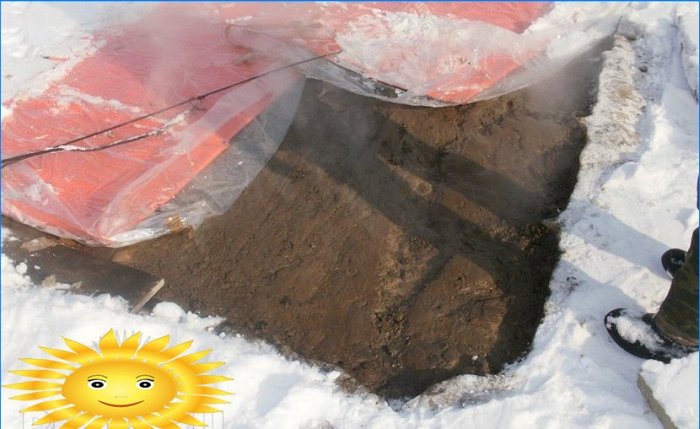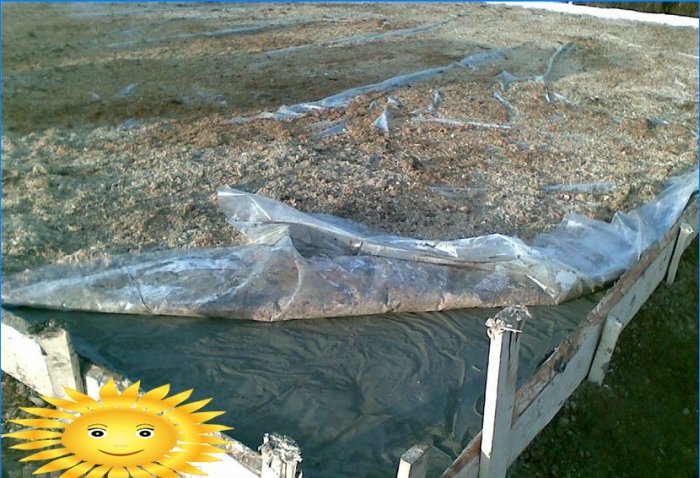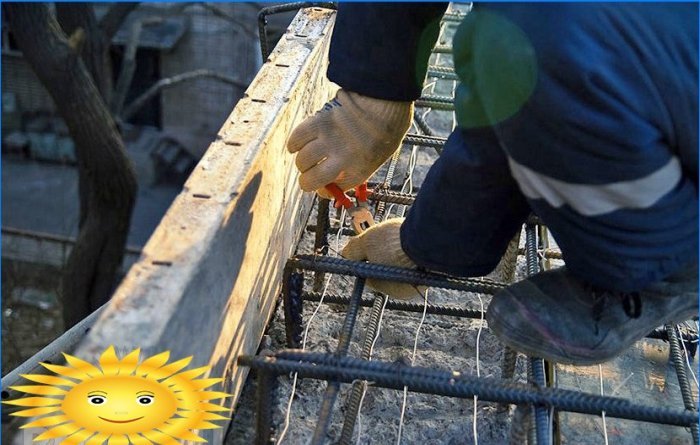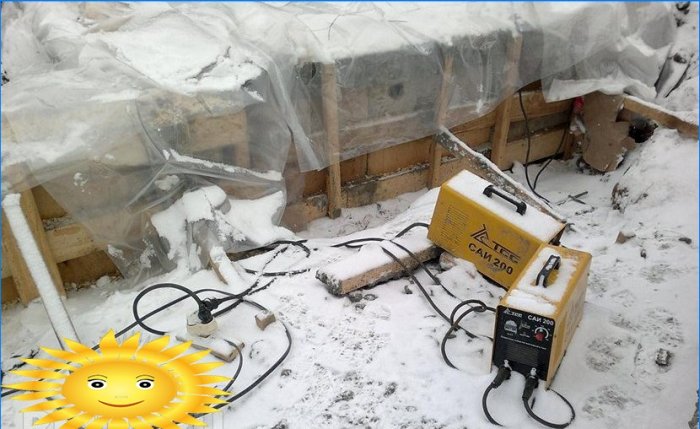Recommendation points
Sub-zero temperatures negatively affect the hydration of the concrete mix. The main task of winter concreting is to retain moisture and maintain the required temperature regime for optimal concrete setting. Today we will consider simple techniques that allow you to carry out concrete work in the winter..
The geographical position of our country dictates its own rules and technologies for all types of construction work carried out during the cold season. With an increase in negative temperatures, concrete work is possible only on those sites where the technical possibility of electric heating or another type of heating of the concrete mixture is pre-laid. As you may have guessed, we are talking about large construction sites, where, regardless of weather conditions, concrete must be poured within strictly defined terms..
Subzero temperatures negatively affect the hydration (curing time) of the concrete mix. Let’s remember what it consists of: cement, sand, water and gravel. Water is a catalyst for the chemical reaction of the concrete setting process. At negative temperatures, moisture freezes, which is extremely necessary for the curing process, the loss of concrete strength jeopardizes all further types of work. The main task of winter concreting is to retain moisture and maintain the desired temperature regime for optimal concrete setting. If the moisture in the concrete mixture has crystallized, then this concrete can no longer be saved, and you should not wait for a thaw – this process is irreversible.
Recommended standards for winter concreting:
- Optimum temperature for concrete setting + 10 … + 20 ° C.
- At a temperature of -20 … + 10 ° C, measures must be taken to ensure the normal hydration of concrete.
- When the temperature drops below -20 ° C, all types of concrete work are prohibited.
Methods for heating concrete at home
At a temperature of 0… + 10 ° C, it is allowed to work with concrete, provided that plasticizers are added, which prevent the mixture from losing the required strength set. Depending on the ambient temperature, the additive is diluted strictly in the proportion indicated in the attached instructions. You can buy an antifreeze additive at any hardware store.
The disadvantage of plasticizers is a slow set of strength, if at +17 ° C concrete gains its branded strength in 7 days, then at +7 ° C with the use of plasticizers the process can take up to 30 days. In order to speed up the setting of concrete, after pouring it must be insulated with improvised means that you can easily find in your household. If a concrete slab is poured, it is advisable to cover it with sawdust, which will almost halve the hydration process..
Styrofoam and penoflex are perfect as insulation, but buying it for one fill is not very cost-effective. It is much cheaper to buy foam crumbs and fill the slab with it, so that the light crumb is not blown away by the wind, it must be covered with an oilcloth or tarpaulin, pressing it along the perimeter of the slab to be poured.
Columns and walls are protected by formwork, but still it will not be superfluous to cover open areas of concrete with the same oilcloth or tarpaulin. During the curing of concrete, a chemical reaction occurs, due to which the concrete mixture itself emits a certain amount of heat, which must be retained with additional insulation.
If the thermometer drops below zero, then the heat generated is no longer enough. At industrial construction sites, special transformers are used to heat concrete at subzero temperatures, through which concrete is heated with heating wires.
Buying a special transformer in order to pour a couple of cubes of concrete in frost is not a very good idea. As such a transformer, it is quite realistic to use a conventional welding transformer for 150-200 A. Below is a list of materials required for heating a small plate with a welding machine:
- Welding machine 150-200 amperes.
- PNSV wire 1.5mm.
- Single aluminum wire AVVG 1×2.5mm.
- HB insulating tape (black).
- Current Clamp.
Preparing to warm up
The PNSV heating wire must be cut into pieces 17-18 meters long. The resulting segments (loops) are evenly laid and tied up along the entire reinforcing cage of the poured structure. We lay the hinges in such a way that after pouring they are just above the middle of the slab, if a column or wall is poured, the layer of concrete above the hinges should be at least 4 cm. It is best to tie the heating wire with an insulated aluminum wire. It should not go in a stretch, ideally it should be arranged in a wave-like order. The distance between the loops, depending on the air temperature, ranges from 10 to 40 cm. The lower the freezing temperature, the smaller the distance between the loops. The number of heating loops depends on the power of the welding machine. One loop consumes 17-25 amperes, which means 6-8 warm-up loops is the maximum that will pull the welding machine by 250 amperes.
When laying the loops, it is important to mark the ends, as an option, wind a strip of electrical tape on one end of each loop, and leave the other end free.
After the hinges are laid and tied, you need to build up aluminum ends on them, which are then connected to the device. The length of the cold ends is determined by the location of the welding machine itself, but not more than 8 meters. Splicing the loop and the cold end using a twist 4–5 cm long. Carefully insulate the twist with HB tape and lay it in such a way that after pouring it remains in the concrete, since the twist will burn out in air. The marking with electrical tape must be transferred to the attached cold end of the loop.
Connection and warm-up
After pouring, all cold ends must be connected to the welding machine, the ends with and without marking are put on different poles of the machine. After everything is connected, we check the entire heating circuit and turn on the device at the minimum load of the power regulator. With a current clamp, we measure each loop separately, the norm is 12-14 amperes. After an hour we add half the power reserve of the device, after two hours we unscrew the regulator completely. It is very important to evenly add amperes to the heating loops, no more than 25 amperes should be shown on each loop. At -10 ° C, 20 amps per loop provides the normal temperature needed for the concrete to cure. As the concrete sets, the loop amperage falls, which makes it possible to gradually increase it on the welding machine. Before increasing, we look whether the value on the loops themselves has fallen or not. If the amperage has not changed since the last check, then we wait for it to fall by at least 10%, and only after that we increase the current.
The warm-up time depends on the fill volume and the ambient temperature. As well as in concreting with additives, we additionally insulate the poured structure. In case of frost up to 10 degrees, 48 hours is enough for normal concrete hydration. After the heating loops are turned off, additional insulation remains for at least 7 more days. Do not overheat the concrete, as this is fraught with excessive evaporation of moisture, which will subsequently lead to the formation of cracks and loss of concrete strength. The slab under the insulation should be a little warm and nothing more. Heating concrete with a welding machine at home requires increased electrical safety measures and should be performed only if you have the necessary knowledge of electrical engineering and professional skills to work with the welding machine.
In the absence of a welding machine, you can use the old method of warming up – “thermal tent”. When pouring small structures, a tent made of tarpaulin or plywood is erected above them, in which the air is heated with the help of heat guns or gas heaters. With this heating method, the Miracle Stoves, which run on diesel fuel, have proven themselves well. With an economical fuel consumption (2 liters for 12 hours), one furnace heats up 10-15 cubic meters of air from the thermal tent to the desired temperature of concrete hydration.








What are the different methods of heating concrete during winter when pouring the foundation?
What are the most effective methods for heating concrete during the winter season when pouring the foundation? Are there any specific techniques or equipment that can efficiently warm the concrete to ensure a successful foundation installation in cold temperatures?
What are the most effective methods of heating concrete during winter when pouring the foundation? Are there any specific techniques or equipment that ensure the concrete sets properly despite the cold temperatures?
What are the most effective methods of heating concrete during winter for pouring foundations?